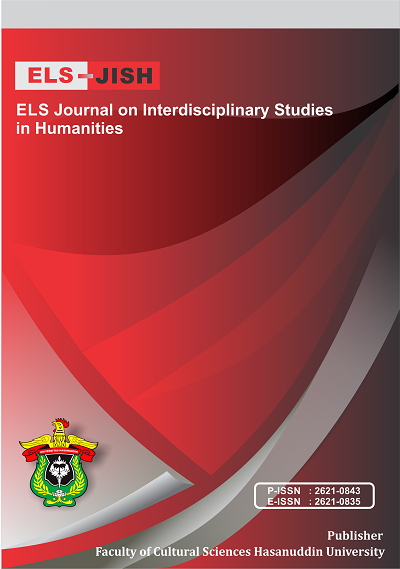Strengths and Weaknesses of Self-Regulated Learning through YouTube: Indonesian EFL Students’ Perceptions
DOI:
https://doi.org/10.34050/elsjish.v3i4.11749Keywords:
EFL Students’ Perception, Strengths, Weaknesses, Self-regulated Learning, YouTube, Learning EnglishAbstract
The recent advancements in technology are growing rapidly, because of that the demands of Internet are increasing rapidly. Include the use of website and application. Technology has brought various potentials for language learning. Therefore, in this research the aims are to determine the perceptions of EFL students and the strengths and weaknesses of self-regulated learning using YouTube. To achieve the objective of the research, the method used in this research is a case study. The data in this research were collected through in-depth interviews. The subjects in this research were four undergraduate students who are majoring in English education from university in Indonesia and they were purposively selected, so that they can provide sufficient information. The results in this research showed the positive perceptions of students towards EFL students self-regulated learning using YouTube. They declared that the use of YouTube could facilitate them in regulating their learning English, brings joy, pleasure and excitement during the learning process. In addition, in this research found out that the strengths of self-regulated learning using YouTube; YouTube provides a lot of learning materials, the ease to use YouTube, flexibility of time and place when using YouTube in regulating their learning. Meanwhile the weaknesses are financial constraints and problem of Internet connectivity.Downloads
References
Almurashi, W. A. (2016). The Effective Use of YouTube Videos for Teaching English Language in Classrooms as Supplementary Material at Taibah University in Alula. International Journal of English Language and Linguistics Research.
Brandl, K. (2012). Effects of required and optional exchange tasks in online language learning environments. ReCALL. https://doi.org/10.1017/S0958344011000309
Casillano, N. F. B. (2019). Challenges of Implementing an E-Learning Platform in an Internet Struggling Province in the Philippines. Indian Journal of Science and Technology, 12(10), 1–4. https://doi.org/10.17485/ijst/2019/v12i10/137594
Cavus, N., & Ibrahim, D. (2017). Learning English using children’s stories in mobile devices. British Journal of Educational Technology. https://doi.org/10.1111/bjet.12427
Chau, C. (2010). YouTube as a participatory culture. New Directions for Youth Development. https://doi.org/10.1002/yd.376
Ertmer, P. A., Newby, T. J., & MacDougall, M. (1996). Students’ responses and approaches to case-based instruction: The role of reflective self-regulation. American Educational Research Journal. https://doi.org/10.3102/00028312033003719
Garcia, T., & Pintrich, P. R. (1994). Regulating motivation and cognition in the classroom: The role of self-schemas and self-regulatory strategies. Self-Regulation of Learning and Performance: Issues and Educational Applications.
Hadijah, S. (2016). Teaching by using video: Ways to make it more meaningful in EFL classrooms. Proceedings of the Fourth International Seminar on English Language and Teaching ISELT-4.
Heriyanto, D. (2018). The Effectiveness of Using Youtube for Vocabulary Mastery. ETERNAL (English Teaching Journal). https://doi.org/10.26877/eternal.v6i1.2290
Kelsen, B. (2009). Teaching EFL to the iGeneration: A survey of using YouTube as supplementary material with college EFL students in Taiwan. Call-EJ Online.
Lewis, T., & Vialleton, E. (2011). The notions of control and consciousness in learner autonomy and self-regulated learning: A comparison and critique. Innovation in Language Learning and Teaching. https://doi.org/10.1080/17501229.2011.577535
McLoughlin, C., & Lee, M. J. W. (2010). Personalised and self regulated learning in the Web 2.0 era: International exemplars of innovative pedagogy using social software. Australasian Journal of Educational Technology. https://doi.org/10.14742/ajet.1100
Merchant, G. (2009). Web 2.0, new literacies, and the idea of learning through participation. English Teaching.
Mokhtari, K., Delello, J., & Reichard, C. (2015). Connected yet distracted: Multitasking among college students. Journal of College Reading and Learning. https://doi.org/10.1080/10790195.2015.1021880
Moran, L. (2013). Introducing flexible learning. 2009, 1–21. www.deakin.edu.au/itl/.../flexiblelearning-m2.doc
Muhammad, A.-I., Alqahtani, E. T., Na’eem, O., & Abdelrahman, B. (2014). Kingdom of Saudi Arabia Ministry of Higher Education Effectiveness of Using YouTube on Enhancing EFL Students’ Listening Comprehension Skills Riyadh-Saudi Arabia. 1–62. https://www.awej.org/images/Theseanddissertation/EbtissamAlqahtani/ebtissamalqahtanifullthesis.pdf
Müller, C., Stahl, M., Alder, M., & Müller, M. (2019). Learning Effectiveness and Students’ Perceptions in A Flexible Learning Course. European Journal of Open, Distance and E-Learning, 21(2), 44–52. https://doi.org/10.2478/eurodl-2018-0006
Rahman, F., & Amir, P. (2019). Trends in Reading Literary Fiction in Print and Cyber Media by Undergraduate Students of Hasanuddin University. International Journal of Education and Practice, 7(2), 66-77.
Thorne, S. L., Black, R. W., & Sykes, J. M. (2009). Second language use, socialization, and learning in internet interest communities and online gaming. Modern Language Journal. https://doi.org/10.1111/j.1540-4781.2009.00974.x
Walgito, B. (2010). Pengantar Psikologi Sosial. Yogyakarta: Andi Ofset.
Watkins, J., & Wilkins, M. (2011). Using YouTube in the EFL Classroom. Language Education in Asia. https://doi.org/10.5746/leia/11/v2/i1/a09/watkins_wilkins
Zhao, Y. (2005). Technology and Second Language Learning: Promises and Problems. Flora, January, 1–31.
Zimmerman, B. J. (1995). Self-Regulation Involves More Than Metacognition: A Social Cognitive Perspective. Educational Psychologist. https://doi.org/10.1207/s15326985ep3004_8
Zimmerman, B. J. (2000). Attaining self-regulation: A social cognitive perspective. Handbook of Self-Regulation.
Downloads
Published
How to Cite
Issue
Section
License

This work is licensed under a Creative Commons Attribution-NonCommercial 4.0 International License.

















